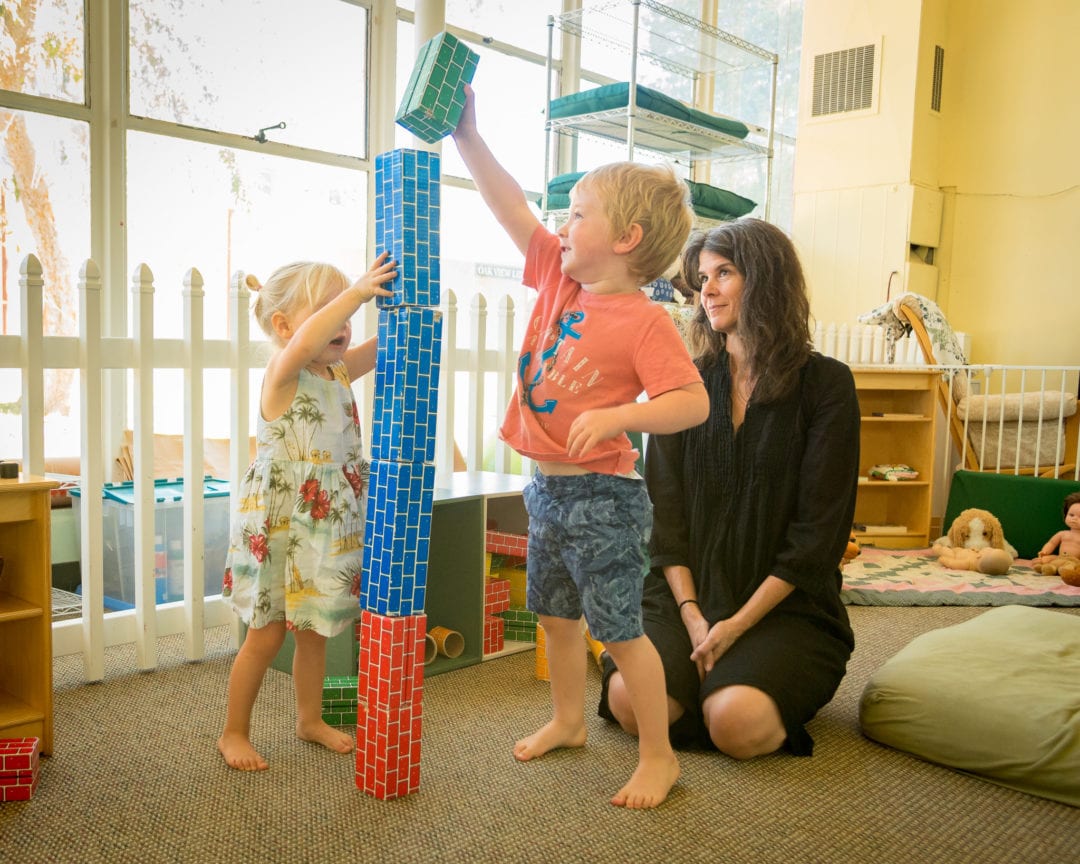
The Importance of Play in Children’s Development
written by Brenda Murrow, Practicum Student
Article Summary: At Secure Beginnings, our classes encourage time for uninterrupted play. Interacting with children in this way may be unfamiliar because play is often more structured and initiated by adults. This article explains what uninterrupted play is and why it is important to development, from a psychological perspective. One theorist describes the activity of play occurring in a “potential space” between child and caregiver, and this article explores this theory as a foundational reason for this core piece of Secure Beginnings methodology.
What is Uninterrupted Play?
Time for uninterrupted play is designed into each of our classes because we feel it is an important activity for children of all ages. Uninterrupted play, per Secure Beginnings’ perspective, is a time where children are able to choose the type of play in which they want to engage; it is ‘child-led’ or ‘child-directed’ activity. Time for uninterrupted play is one of the Basic Principles of Resources for Infant Educarers (RIE) – and as you may know, our Secure Beginnings methodology includes some RIE ideas. Uninterrupted play may include a choice from a variety of toys, may be with the parent or caregiver, and may be with other peers in the class. The boundary to the play is that it is safe and age-appropriate for the child. The main element of uninterrupted play is that the adults, very consciously, do not influence the child’s choices.
How will children grow up to be adults in a world that demands their attention and skill, and have the necessary social capacities to be successful, if we do not teach them?
Uninterrupted play is a different way of interacting with children than is traditionally ‘the norm’ and it may seem difficult at first. Even with more recent parenting trends such as “attachment parenting,” there can be an expectation that children need to be led or directed, so that they know “what to do.” And, this seems especially true when children come to a class. It certainly is true that children need our support and guidance. However, in addition, they also need space to develop their own capacities, and uninterrupted play assists them in doing so because it allows children to experience their worlds in their own ways. The development of strategies for navigating life occurs at each age and certainly require caregiver assistance; however when these capacities most truly match who the person is, they are the most resilient. The idea is that the child has a unique identity inside of them that emerges over time as they develop. As this identity, or self, emerges, the child enjoys assistance from others in the discovery process. Caregivers can encourage this development, i.e. self-development, by supporting the uniqueness of the child, and one way to do this is through interacting with them as they express themselves in uninterrupted play. In this way the child develops capacities to be successful that match who they are as individuals.
If the play activity is uninterrupted, then what is my role?
This is one of the most important parts: the caregiver’s role is to be ready to be a figure in the play of the child, to be attentive to the child’s wishes (again, without influencing what they might be), and to be willing to listen and respond to the child’s requests.
The Experience of Play
Have you noticed what it feels like to enter into this kind-of play with a child? Very quickly an awareness occurs, when both caregiver and child begin to play, this awareness seems to communicate mutual interest in playing, sharing an intention to co-creating something together, a unique expression of play between the two involved. It is as though you and the child share a common understanding, it may feel as though there is a small world that encompasses you both, and things happen that those outside the world do not comprehend. Symbols begin to take on meaning in this small world, for example, what to others may look like a book becomes a gift to be given and re-given, back and forth to each other. From inside this new world, a few exchanges of giving the book back and forth occur and all of the sudden there are customs that accompany the gift giving, perhaps a smile with squinted eyes of anticipatory delight accompanies the act of giving the gift, and a smile with wide, surprised eyes accompanies its receipt. The child and caregiver know the customs in their shared world, and they know the feeling of participating in those shared customs. Each also seem to know that to break custom would mean not only a change in the play, but a change in the world that has them encompassed. This change would require new understandings of customs, and may require a reformulation of the symbols. We are entering and exiting these shared worlds all the time when we play with children, and we need to understand more about their importance.
What is Potential Space?
A psychologist named D.W. Winnicott called these shared worlds of interaction “potential space.” In his work, Winnicott observed the interactions of mothers and babies, and was very interested in these interactions especially the non-verbal communications being shared between the mother and baby. He noticed that, in addition to play symbols and customs, mother and baby could share information about each other’s moods, emotions, alertness, perceptions, etc. in a mutual way. In fact, most psychologists now believe it is impossible for these internal states not to be shared between mothers and babies, and between all beings regardless of age. To conceptualize this mutual sharing of internal feelings, and to draw attention to the idea that it is something that occurs between two individuals, he chose to represent it as a place, and thus the term, “potential space.”
About Potential Space, Winnicott said, it is a place “where we most of the time are when we are experiencing life.” He said it is neither when we are focused on the behavior we are doing, or contemplating the thoughts we are thinking, but when we are having an experience of life.
Winnicott was writing in the 1970s and now we have a lot of new terms to define this experience, such as being able to “be present to the moment.” If we think of what the feeling is to experience this ourselves, or to be around someone who is, most likely we feel a sense of time slowing down a bit, things calming, and sense of resting (often called a sense of being grounded). When interacting with children in this way, we approach the interaction with a feeling of curiosity about the child and are very interested in who she is, rather than whom she needs to be.
The reason this capacity is important for children’s development is that Winnicott theorized that it is in this “space” that a child’s potential can be realized. In other words, this space that is neither behaviors nor thoughts, is where children have a chance to become themselves, that is to develop into their unique selves.
I like to conceptualize it in terms of a music example; in fact the word often applied to this way of being is “attunement” which means to bring into harmony. If as caregivers, we give the child enough room, she will fill the area with her own tune and as she realizes we are there, listening attentively and willing to harmonize, there is no limit to the beauty of song she will lead and that we can co-create with her. This capacity in a child leads to an understanding of themselves and the world around them that supports their ventures into it.
At Secure Beginnings, we strive to provide environments that support the potential space of children, and we enjoy sharing with you the delight of watching what they create and become.
Are you interested in learning more about D.W. Winnicott’s theories? Most of the information in this article is derived from his book Playing and Reality (1971), particularly the essay entitled “The Place Where We Live.”

